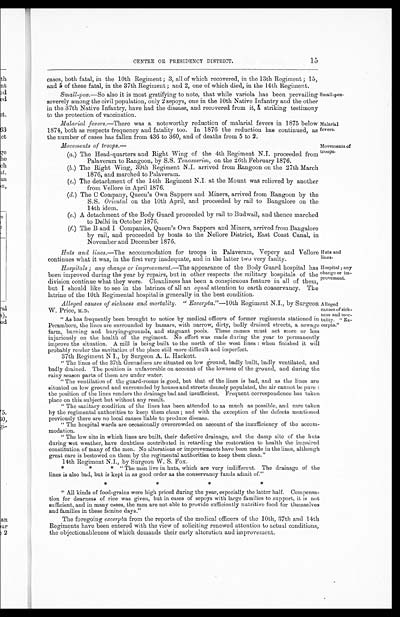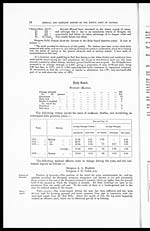Medicine - Institutions > Army health reports and medical documents > Medical and sanitary reports of the native army of Madras > Medical and sanitary report of the native army of Madras for the year 1876
(24) Page 15
Download files
Individual page:
Thumbnail gallery: Grid view | List view

CENTRE OR PRESIDENCY DISTRICT.
15
cases, both fatal, in the 10th Regiment; 3, all of which recovered, in the 13th Regiment; 15,
and 5 of these fatal, in the 37th Regiment; and 2, one of which died, in the 14th Regiment.
Small-pox. —So also it is most gratifying to note, that while variola has been prevailing
severely among the civil population, only 2 sepoys, one in the 10th Native Infantry and the other
in the 37th Native Infantry, have had the disease, and recovered from it, a striking testimony
to the protection of vaccination.
Small-pox.
Malarial fevers. —There was a noteworthy reduction of malarial fevers in 1875 below
1874, both as respects frequency and fatality too. In 1876 the reduction has continued, as
the number of cases has fallen from 436 to 360, and of deaths from 5 to 2.
Malarial
fevers.
Movements of troops.—
Movements of
troops.
(a .) The Head-quarters and Right Wing of the 4th Regiment N.I. proceeded from
Palaveram to Rangoon, by S.S. Tenasserim, on the 26th February 1876.
(b .) The Right Wing, 39th Regiment N.I. arrived from Rangoon on the 27th March
1876, and marched to Palaveram.
(c .) The detachment of the 14th Regiment N.I. at the Mount was relieved by another
from Vellore in April 1876.
(d .) The C Company, Queen's Own Sappers and Miners, arrived from Rangoon by the
S.S. Oriental on the 10th April, and proceeded by rail to Bangalore on the
14th idem.
(e .) A detachment of the Body Guard proceeded by rail to Budwail, and thence marched
to Delhi in October 1876.
(f .) The B and I Companies, Queen's Own Sappers and Miners, arrived from Bangalore
by rail, and proceeded by boats to the Nellore District, East Coast Canal, in
November and December 1876.
Huts and lines. —The accommodation for troops in Palaveram, Vepery and Vellore
continues what it was, in the first very inadequate, and in the latter two very faulty.
Huts and
lines.
Hospitals; any change or improvement. —The appearance of the Body Guard hospital has
been improved during the year by repairs, but in other respects the military hospitals of the
division continue what they were. Cleanliness has been a conspicuous feature in all of them,
but I should like to see in the latrines of all an equal attention to earth conservancy. The
latrine of the 10th Regimental hospital is generally in the best condition.
Hospital; any
change or im-
provement.
Alleged causes of sickness and mortality. "Excerpta."— 10th Regiment N.I., by Surgeon
W. Price, M.D.
Alleged
causes of sick-
ness and mor-
tality. "Ex-
cerpta."
"As has frequently been brought to notice by medical officers of former regiments stationed in
Perambore, the lines are surrounded by bazaars, with narrow, dirty, badly drained streets, a sewage
farm, burning and burying-grounds, and stagnant pools. These causes must act more or less
injuriously on the health of the regiment. No effort was made during the year to permanently
improve the situation. A mill is being built to the north of the west lines: when finished it will
probably reader the sanitation of the place still more difficult and imperfect.
37th Regiment N I., by Surgeon A. L. Hackett.
"The lines of the 37th Grenadiers are situated on low ground, badly built, badly ventilated, and
badly drained. The position is unfavorable on account of the lowness of the ground, and during the
rainy season parts of them are under water.
"The ventilation of the guard-rooms is good, but that of the lines is bad, and as the lines are
situated on low ground and surrounded by houses and streets densely populated, the air cannot be pure:
the position of the lines renders the drainage bad and insufficient. Frequent correspondence has taken
place on this subject but without any result.
"The sanitary condition of the lines has been attended to as much as possible, and care taken
by the regimental authorities to keep them clean; and with the exception of the defects mentioned
previously there are no local causes liable to produce disease.
"The hospital wards are occasionally overcrowded on account of the insufficiency of the accom-
modation.
"The low site in which lines are built, their defective drainage, and the damp site of the huts
during wet weather, have doubtless contributed in retarding the restoration to health the impaired
constitution of many of the men. No alterations or improvements have been made in the lines, although
great care is bestowed on them by the regimental authorities to keep them clean."
14th Regiment N.I., by Surgeon W. S. Fox.
"The men live in huts, which are very indifferent. The drainage of the
lines is also bad, but is kept in as good order as the conservancy funds admit of."
"All kinds of food-grains were high priced during the year, especially the latter half. Compensa-
tion for dearness of rice was given, but in cases of sepoys with large families to support, it is not
sufficient, and in many cases, the men are not able to provide sufficiently nutritive food for themselves
and families in these famine days."
The foregoing excerpta from the reports of the medical officers of the 10th, 37th and 14th
Regiments have been entered with the view of soliciting renewed attention to actual conditions,
the objectionableness of which demands their early alteration and improvement.
Set display mode to: Large image | Zoom image | Transcription
Images and transcriptions on this page, including medium image downloads, may be used under the Creative Commons Attribution 4.0 International Licence unless otherwise stated. ![]()
| Permanent URL | https://digital.nls.uk/74991376 |
|---|




